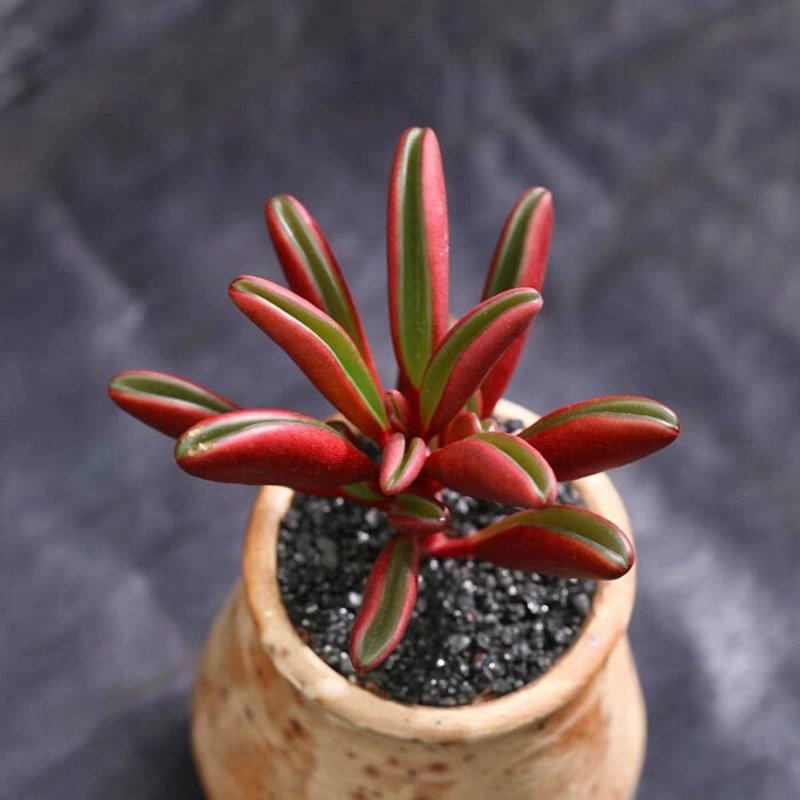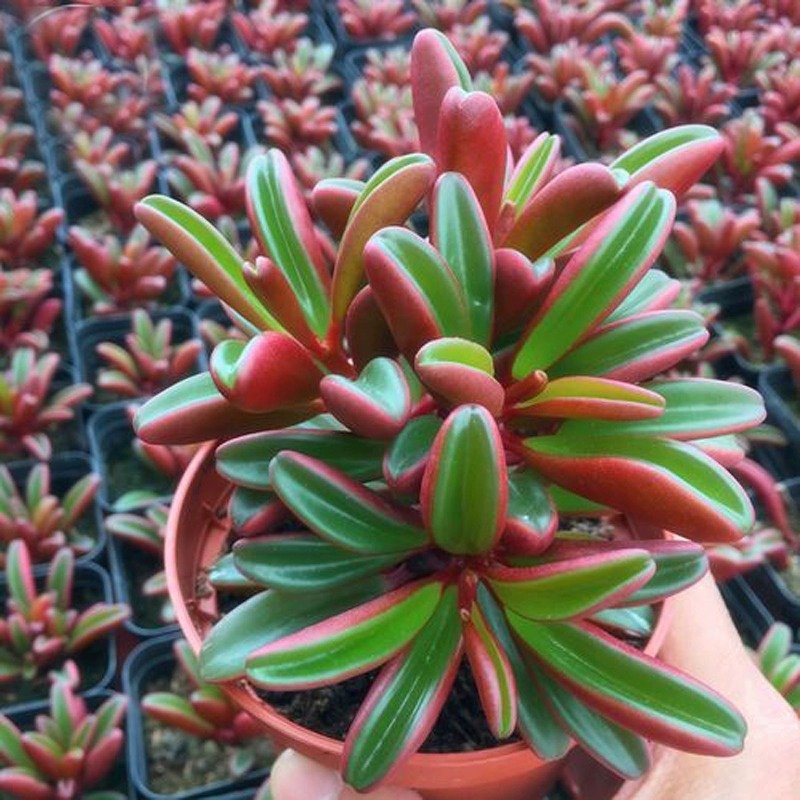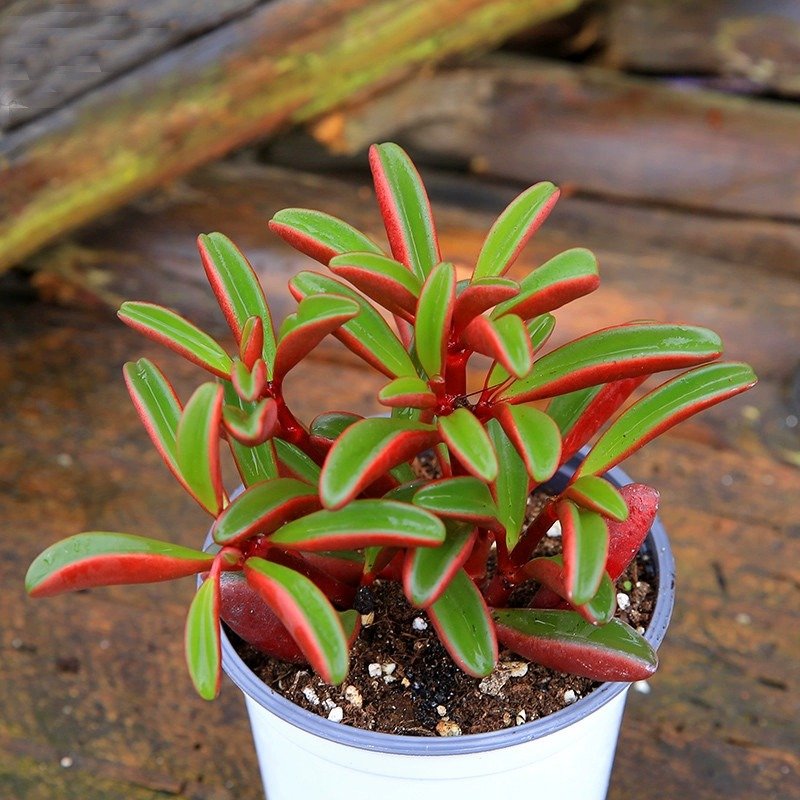
If you want a plant that looks special, the ruby glow peperomia adds bright color and beauty to your room. This peperomia claveolens has thick leaves like a succulent, with a red bottom side. It is easy to grow, even if you have never had houseplants before. To keep your ruby glow peperomia happy, let the soil dry before you water it, use soil that drains well, and put it in bright but not direct sunlight. Many new plant owners water too much or put their ruby glow peperomia in direct sun, which can hurt the roots or leaves. Stay away from these mistakes and your peperomia claveolens will grow well without much work. Ruby glow peperomia is a good plant for anyone who wants easy peperomia care and a colorful plant inside.
Key Takeaways
- Put your ruby glow peperomia in bright, indirect light. This helps the leaves stay colorful and healthy. Do not put it in direct sun because that can burn the leaves.
- Only water when the top inch or two of soil feels dry. Use pots with holes at the bottom so extra water can drain out. Pick soil that lets water flow through easily. This stops root rot from happening.
- Use a loose, chunky soil mix like cactus or orchid mix. Add perlite and peat moss to the soil. Pick terracotta or clay pots for better air flow.
- Keep your plant in a warm place between 65°F and 80°F. Feed it a little bit once a month in spring and summer.
- You can make new plants with stem cuttings. Watch out for pests like mealybugs. If you see yellow leaves or long, thin growth, change the light or water to fix it.
Light for Peperomia claveolens

Bright Indirect Light
Your ruby glow peperomia loves indirect bright light. This means you should place your plant where sunlight fills the room but does not shine directly on the leaves. Think about spots near a window with a sheer curtain or a table a few feet away from a sunny window. In nature, these plants grow under trees, so they get dappled sunlight. If you want the best color and healthy growth, give your ruby glow peperomia medium to bright light. This helps the leaves stay thick and vibrant. During winter, move your plant closer to a window to catch more light, since days are shorter and the sun is weaker.
Tip: Rotate your ruby glow peperomia every week. This helps all sides get enough indirect bright light and keeps the plant growing evenly.
Avoiding Direct Sun
Direct sunlight can hurt your ruby glow peperomia. If you put it right on a sunny windowsill, the leaves might burn or turn yellow. The plant’s beautiful red and green colors can fade or get brown spots. Most peperomia claveolens do not like strong afternoon sun, especially in summer. In winter, a little morning sun is okay, but always watch for signs of stress. Remember, indirect bright light is the safest choice all year.
- Place your ruby glow peperomia less than three feet from a south-facing window, but not right in the sunbeam.
- Use a sheer curtain to soften harsh sunlight.
Signs of Light Stress
If your ruby glow peperomia does not get enough light, you might see some warning signs. The leaves can droop or even fall off. The plant may look stretched out or lose its bright color. Horticultural experts say leaf drop and drooping are the most common signs of light stress. If you notice these problems, move your plant to a brighter spot with more indirect bright light. Too much direct sun can also cause trouble, like leaf burn, curling, or yellowing.
- Watch for:
- Drooping leaves
- Leaf drop
- Faded or yellow spots
- Stretched stems
If you see these, adjust your plant’s spot right away. Your ruby glow peperomia will bounce back with the right light.
Watering and Humidity
When to Water
Peperomia claveolens has simple water needs, but you need to pay attention to the soil. You should water your plant only when the top inch or two of soil feels dry. Most people find that this means watering about once every 7 to 10 days indoors. In winter, your plant grows slower, so you can wait even longer between waterings. The thick, succulent-like leaves store water, so the plant can handle a little drought. If you stick your finger in the soil and it feels dry, it’s time to water. If it still feels damp, wait a few more days.
Tip: Always check the soil before you water. This helps you avoid overwatering, which can cause root rot.
Watering Tips
You want to keep your ruby glow peperomia healthy, so follow these growing tips for watering:
- Water at the base of the plant, not on the leaves. This keeps the leaves dry and helps prevent disease.
- Use a pot with drainage holes and well-draining soil. Let extra water drain out after you water.
- Water thoroughly, but don’t let the plant sit in water. Empty the saucer if water collects there.
- In winter, reduce how often you water. The plant uses less water when it’s not actively growing.
Here’s a quick table to help you spot watering problems:
| Symptom | Likely Cause |
|---|---|
| Yellow, mushy leaves | Overwatering |
| Wilting but moist soil | Root rot risk |
| Wrinkled, droopy leaves | Underwatering |
| Leaf drop + soggy pot base | Poor drainage |
If you see yellow, mushy leaves or soggy soil, you might be watering too much. Wrinkled or droopy leaves mean your plant needs more water.
Humidity Needs
Peperomia claveolens does not need high humidity to thrive. Normal room humidity works well for this plant. If your home feels very dry, you can mist the plant lightly or place a tray of water nearby to add a little moisture. Avoid placing your plant right next to heaters or air conditioners, since these can dry out the air. Unlike some tropical plants, ruby glow peperomia does not demand high humidity, so you don’t need to worry much about this part of care. Just keep the air comfortable for yourself, and your plant will be happy too.
Soil and Potting

Best Soil Mix
You want your Peperomia claveolens to thrive, so start with the right soil. This plant loves a loose, chunky, and slightly acidic mix. You can use an orchid potting medium or a cactus and succulent mix. These blends let air reach the roots and help water drain quickly. For even better results, add coconut coir and perlite. These ingredients lighten the soil and boost aeration. Peat moss is also a good choice because it holds just enough moisture without making the soil soggy.
- Use a mix that mimics the plant’s natural habitat.
- Combine perlite, peat moss, and orchid bark for a healthy root environment.
- Avoid heavy garden soil or mixes that stay wet for too long.
Note: If you use soil that holds too much water, your plant may suffer from root rot. Even if you water carefully, soggy soil can cause roots to decay and stems to collapse.
Pot Choice
Picking the right pot makes a big difference in your plant’s health. Terracotta or clay pots work best because they let water evaporate and air move around the roots. Plastic and ceramic pots hold in moisture, which can lead to problems. Always choose a pot with drainage holes. This prevents water from pooling at the bottom and keeps roots safe.
- Select a pot that is just 1–2 inches wider than the root ball.
- Avoid very large pots, as they hold extra soil and moisture.
- Let your plant stay a little root-bound. Only repot when you see roots poking out or the soil gets hard.
A quick table for pot selection:
| Pot Material | Pros | Cons |
|---|---|---|
| Terracotta | Breathable, dries quickly | Can break easily |
| Clay | Good air flow, classic look | Heavier than plastic |
| Plastic | Lightweight, cheap | Holds too much water |
Drainage Tips
Good drainage is key for successful cultivation of Peperomia claveolens. Here’s how you can make sure your plant never sits in water:
- Always use a pot with drainage holes.
- Fill the pot with a well-draining soil mix, like cactus mix with added perlite.
- Repot only when the plant is very root-bound, and use a pot just a bit bigger than before.
- Refresh the soil during repotting to keep it light and airy.
Tip: Never use a pot without drainage holes. Water will build up, and your plant’s roots could rot.
If you follow these steps, your Peperomia claveolens will have healthy roots and strong growth.
Temperature and Feeding
Ideal Temperature
Peperomia claveolens likes steady, warm temperatures. You should keep your plant in a room that stays between 65°F and 80°F (18°C to 27°C). This range helps your ruby glow peperomia grow strong and healthy. If your home gets colder than 60°F (16°C), your plant may start to struggle. Cold drafts from windows or doors can also cause problems. Try to keep your plant away from air conditioners, heaters, or spots where the temperature changes quickly.
When your peperomia feels too hot or too cold, it will show you. Watch for these signs of temperature stress:
- Leaves turn yellow or dark.
- The plant starts to wilt.
- Leaves curl up tightly, especially if the room is cold.
- Leaves drop off when it gets too hot.
- Growth slows down or stops.
- Sudden changes in temperature, drafts, or direct sun make these problems worse.
If you see any of these signs, move your plant to a more stable spot. A shelf or table away from vents and windows works well. Your peperomia will thank you with healthy, colorful leaves.
Tip: Keep your plant in the same room as you. If you feel comfortable, your peperomia probably does too!
Fertilizer Guide
You do not need to feed your ruby glow peperomia very often. This plant grows slowly and does not use much fertilizer. Use a balanced, water-soluble houseplant fertilizer. Look for one with equal numbers, like 10-10-10 or 20-20-20. Feed your plant once a month during spring and summer. In fall and winter, stop feeding because the plant rests.
Here is a quick table to help you remember:
| Season | How Often to Fertilize |
|---|---|
| Spring/Summer | Once a month |
| Fall/Winter | Do not fertilize |
Always mix the fertilizer at half the strength listed on the package. Too much food can burn the roots. Water your plant before you feed it to protect the roots. If you see brown tips or slow growth after feeding, use less fertilizer next time.
Note: Less is more with peperomia. Your plant will grow best with gentle care and light feeding.
How to Care for Peperomia Indoors
Propagation Steps
You can easily grow more ruby glow peperomia by using stem cuttings. This method works well for beginners and gives you new plants to share or keep. Here’s how you do it:
- Pick a healthy stem with at least two leaves. Use clean scissors or pruning shears.
- Cut the stem just below a leaf node. The node is where new roots will grow.
- Remove the bottom leaves, leaving a few at the top.
- Let the stem cuttings dry for a few hours. This helps prevent rot.
- Place the stem cuttings in a small pot with well-draining soil. You can also use water, but soil works best for ruby glow peperomia.
- Keep the soil slightly moist, not soggy. Put the pot in bright, indirect light.
- Roots should appear in two to four weeks. Gently tug the cutting to check for resistance.
- Once roots grow, treat your new plant like a mature ruby glow peperomia.
Tip: Try propagating cuttings in spring or early summer. Plants root faster when the weather is warm.
You can also try propagating cuttings in water. Just place the stem cuttings in a glass of water and change the water every few days. When you see roots, move the cutting to soil.
Common Pests
Ruby glow peperomia usually stays pest-free, but sometimes you might spot a few unwanted visitors. The most common pests for this plant are mealybugs, spider mites, and thrips. These tiny bugs can hide under leaves or along stems. If you see sticky spots, webbing, or tiny moving dots, you might have a pest problem.
Here are some safe and easy ways to handle common pests on houseplants like ruby glow peperomia:
- Pick off snails or slugs by hand if you see them. This is a simple and chemical-free way to protect your plant.
- Sprinkle diatomaceous earth around the base of your plant. It acts as a barrier and keeps soft-bodied pests away.
- Set up beer traps to catch slugs and snails. They crawl in and cannot escape.
- Use crushed eggshells or coffee grounds on the soil. These make it hard for pests to move and can add nutrients, but use coffee grounds sparingly.
- Place copper tape around your pot. It gives slugs and snails a mild shock, so they stay away.
- Avoid using salt. It can harm your soil and your ruby glow peperomia.
- For bugs like mealybugs or spider mites, spray the plant with organic insect soap or neem oil. Repeat every few days until the pests are gone.
Note: Check your houseplants often. Early action keeps pests from spreading to other plants.
Troubleshooting
Sometimes, even with the best care, your ruby glow peperomia may show signs of trouble. Don’t worry! Most problems have simple fixes. Here are some growing tips to help you solve the most common issues:
- Yellow Leaves: This often means you are watering too much or your plant needs more light. Let the soil dry out before watering again. Move your plant to a brighter spot with indirect light.
- Leaf Curl or Drop: Overwatering can cause leaves to curl or fall off. Only water when the top inch or two of soil feels dry. Make sure your pot has drainage holes.
- Root Rot: If you notice mushy stems or a bad smell, your plant may have root rot. Take the plant out of the pot, trim away any black or mushy roots, and repot in fresh, well-draining soil.
- Pest Infestation: If you see tiny bugs or webbing, use organic soap sprays or neem oil. Remove badly damaged leaves.
- Deformed or Twisted Leaves: This can mean your plant needs more calcium. Add a little bone meal or crushed eggshells to the soil.
- Leggy Growth: If your ruby glow peperomia looks stretched out, it needs more light. Move it closer to a window, but avoid direct sun.
- Guttation (Water Droplets on Leaf Tips): This happens when you water too much. Cut back on watering and make sure no water sits in the saucer.
Here’s a quick troubleshooting table for your ruby glow peperomia:
| Problem | Likely Cause | Solution |
|---|---|---|
| Yellow leaves | Overwatering, low light | Water less, move to brighter spot |
| Leaf curl/drop | Overwatering | Let soil dry, check drainage |
| Mushy stems/root rot | Poor drainage | Repot in fresh, well-draining soil |
| Pests (mealybugs, mites) | Infestation | Use organic soap spray, remove pests |
| Twisted leaves | Calcium deficiency | Add bone meal or eggshells |
| Leggy growth | Not enough light | Move to brighter, indirect light |
Tip: Prune any leggy or damaged stems by pinching back to a leaf node. This helps your plant grow bushier and healthier.
If you follow these steps, you will master how to care for peperomia and enjoy a thriving ruby glow peperomia in your home. Good cultivation habits and regular checks will keep your houseplants looking their best.
Here’s a quick checklist for your Peperomia claveolens:
- Give it bright, indirect light.
- Let the soil dry before watering.
- Use chunky, well-draining soil.
- Keep it in a warm, steady spot.
- Feed lightly in spring and summer.
Scientists found that leaf windows in succulent plants help manage heat, not just light. So, you help your plant by keeping it out of harsh sun and away from big temperature swings. Enjoy growing your ruby glow! Want more? Try adding another easy houseplant to your collection.
FAQ
How often should I repot my Peperomia claveolens?
You only need to repot your plant every two to three years. If you see roots poking out or the soil looks hard, it is time. Pick a pot just a little bigger than the old one.
Can I grow Peperomia claveolens in low light?
You can keep your plant alive in low light, but it will not look its best. The leaves may lose color and growth will slow down. For bright, healthy leaves, place your plant in bright, indirect light.
Why are my Peperomia claveolens leaves wrinkling?
Wrinkled leaves usually mean your plant needs water. Check the soil. If it feels dry, give your plant a drink. If the soil is wet, wait a few days before watering again.
Is Peperomia claveolens safe for pets?
Yes! Peperomia claveolens is non-toxic to cats and dogs. You can keep it in your home without worry. Still, try to keep pets from chewing on the leaves.
What should I do if my plant gets leggy?
If your plant looks stretched out, it needs more light. Move it closer to a window with bright, indirect sunlight. You can also pinch back the stems to help your plant grow bushier.